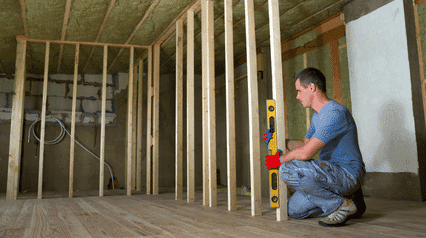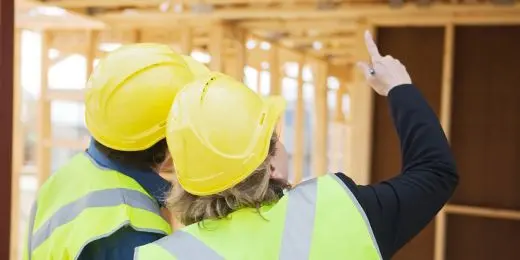What is Remodeling?
The process of remodeling an area entails changing its functionality and appearance. It might be necessary to demolish a wall to expand a bathroom and rearrange the kitchen layout, thus moving the cabinets, refrigerator, sink, and range around. Additionally, any extension to your house would be considered a remodel. Renovating does not always need to be a sizeable structural renovation, but it may be as easy as converting a guest room into a home office. Remodeled areas are those whose intended use has changed.
A remodeling project varies depending on the property owner’s size, condition, and preferences. However, all remodeling projects require careful planning and execution to succeed. With careful planning and attention to detail, remodeling can transform any property.
Renovation vs. Remodeling: The Big Differences
When it comes to home improvement, there are two main terms that people use interchangeably: renovation and remodeling. Some significant differences exist between the two, and understanding them is essential before you start planning your project.
Learn the key differences between a renovation and a remodel, so you can decide which one is right for your home.
Renovation Updates the Aesthetic of a Property Without Changing Its Purpose
A kitchen or a bedroom may remain the same when renovating, but it may undergo repairs and improvements. It generally entails tainting, new flooring installation, and changing cabinet knobs and faucets.
Meanwhile, a property’s renovation entails the demolishing and rebuilding of structural parts as well. You may need to replace a wall, subfloor, or roof if there are pieces of wood that are weak and might break.
Remodeling Changes the Design and Structure of the Property
Remodeling services change a property completely. The completed work may not look like what it once was. Adding and removing walls can change the footprint of a house.
Remodeling can also change the interior layout of the property. For example, a home office could be created by knocking out a wall that separates a bedroom from the rest of the house.
Most of the Time, Remodeling Costs More Than Renovating
Remodeling, like any other repair project, entails the need to change the physical structure of a property. Changing wiring, plumbing, and ductwork to rearrange makes remodeling projects more complex and costly.
A remodel necessitates more skilled labor and hence costs more money. The final cost comparison depends on the scope of the project and the quality of the materials; renovations are generally less complicated and more economical.
Renovating May Not Require a Permit, but Remodeling Almost Always Does
Permits ensure compliance with building codes. Communities have different regulations for remodeling. Although local building authorities will almost always need a permit before any structure is modified, including adding an addition to a house or removing and rebuilding interior walls.
Minor makeovers, such as painting or new carpeting, don’t require permits, but replacing a roof (because design and function are not changed) generally does. Because a new roof might leak and damage the house’s structure if it’s not put on right, reroofing is in a class by itself.
Renovating is More Do-It-Yourself (DIY)-Friendly
If you have the ability, time, and interest to work on your property, consider renovating rather than remodeling. Most communities do not allow unlicensed property owners to wire or install plumbing. But painting, wallpapering, installing new doors, and putting in trim work are all permissible.
Even if a community allows homeowners to undertake their renovations, most do-it-yourselfers may not have the expertise necessary to complete a project like pouring a new foundation for an addition or framing walls and rooflines.
Renovations Offer a Better Return on Investment (ROI)
When it comes to selling a house, renovating is typically less expensive, as it entails simply repairing and upgrading the basic features of a home. When homeowners sell their houses, renovation projects generally result in a higher ROI than remodeling projects because renovating costs less and involves only minor changes.
Remodeling is a Better Way to Fix Bad Home Design
If you go through one bedroom to get from one room to another, or your kitchen sink’s water supply lines are in an outside wall and freeze nearly every winter, improvements will not fix the problem. When a house is poorly planned, remodeling is typically the only option.
Before implementing strict construction rules, older homes had a higher prevalence of poor design.
Only Renovation is Allowed on Some Historic Homes
If you live in a historic district or your home is on the National Register of Historic Places, you may be limited to making only renovations. Any changes you make to the property must keep the home’s historic character. For example, if your home has wooden siding, you may not be able to replace it with vinyl siding.
Sometimes, you may need approval from a local historic preservation commission before proceeding with your project.
Why is Remodeling Necessary?
Depending on how long you plan to live in your home, you may eventually want to update it to suit your changing needs. For example, you might want to add an extra bathroom, enlarge your kitchen, or convert a spare bedroom into a home office. These are all good reasons to remodel your property.
In contrast, if you plan to sell your home, you’ll want to be sure that any remodeling you do will add to the resale value of your home. Generally, the best return on investment (ROI) comes from projects that make your home more attractive to potential buyers. For example, a new kitchen or bathroom will likely appeal to more buyers than a home theater or sunroom.
Remodeling may also be necessary to correct problems with the existing structure of your home. For instance, to fix a cracked foundation or a leaking roof to stop future damage to your home.
Create Your Own Remodeling Inspection Checklist
Eliminate manual tasks and streamline your operations.
Get started for FREEStages of the Remodeling Process
Remodeling can be costly, but they are worth the investment in the long run. There are several stages to the remodeling process, from planning to execution. Here’s a brief overview of what to expect throughout the course of this process.
Site Prep
It is necessary to prepare the site before constructing a new foundation. Trees and shrubs may have to be removed or relocated, and the landscaping contractor can accomplish this task.
Foundation Excavation, Construction, and Backfilling
The contractor would first clear the area and dig to a certain depth to prepare for concrete forms. During this phase, the contractor would handle any required underground electrical wiring or plumbing relocation.
After excavation, the mason or concrete subcontractor may set the forms and pour the foundation footings. Foundation footings need to cure for several days before work can begin.
After curing the footings and completing all necessary inspections, you can use compacted and sloping materials to fill foundation voids.
Demolition and Framing
Once the site is ready, demolition of the existing structure can begin. Typically, a contractor with experience in demolishing and removing houses accomplishes this work. The contractor will remove all debris from the site and dispose of it properly.
Following the demolition of the house, the framing subcontractor will begin work on the new foundation and framing. The framers will erect walls, install roof trusses, and add other structural elements.
Weatherproofing the Property
Installing the roofing materials is the first step in weatherproofing a project. It will protect the frame structure and construction. The second phase in weatherproofing the building is to install windows and doors. Afterward, you can add siding and external trim.
Interior Partitioning
Carpenters will install the stud walls, rough openings for doors, and other components as the floor plan directs. Carpenters may also ensure that mounting blocks and chases are included in the wall sections to assist with Heating, Ventilation, and Air Conditioning (HVAC), electrical, and plumbing routing by following the plans.
Rough Plumbing, Electrical Wiring, and HVAC Installation
The electrician will install the wiring system in the walls and ceilings as directed by the electrical blueprint. The plumber will also install the rough plumbing after the framing is complete. The HVAC contractor will then install the ductwork in the ceilings and floors.
Insulation
The insulation installers will add the necessary insulation to the walls, ceilings, and floors as specified in the energy code.
Drywall Installation
After inspecting all existing fixtures, the installation of wallboard and other finishes can begin. In addition, the contractor will install wall tile and ceramic flooring at the same time as they are constructing the walls.
Flooring Installation
The installation of any wood flooring would follow around this time.
Kitchen or Bath Cabinets
Cabinets and other built-in units are now in use. The countertop installation follows the base cabinet installation.
Finish Plumbing, Electrical, and HVAC
The electrical wiring is complete. You will now need to install the electrical outlets, light fixtures, vent registers, and GFI outlets (if necessary). Typically, inspections of all of these surfaces are required to go forward.
Paint or Wallpaper
After completing all other tasks, the walls and ceiling can be painted or papered.
Appliances Installation and Landscaping
Appliances not installed during construction, such as the oven and dishwasher, are now in place. The landscaping contractor would also finish any remaining work, such as planting trees and shrubs, installing a lawn, and paving driveways or walks.
Certificate of Occupancy
Upon completion of all inspections, the local building authority issues a Certificate of Occupancy, which states that all permit conditions have been satisfied.
Final Walk-Through
A walk-through with the general contractor isn’t only for significant construction; it’s also an essential step in any large remodeling project.
Top 5 Remodeling Mistakes
To avoid making costly mistakes, you should keep a few things in mind when remodeling your residential or commercial space. There are five mistakes that most people make when remodeling:
- Choosing the wrong service provider
- Putting aesthetics ahead of function
- Getting around the permit
- Not making plans for what could go wrong
- Changing your mind all the time
5 Tips for a Successful Remodeling Project
Remodeling can be daunting, but if you follow these five simple tips, you will have a successful project.
Work Within a Set Budget
A project that starts without a budget might be doomed to failure. In rare cases, contractors will come in under budget; in most situations, budgets are frequently exceeded by a significant amount, resulting in projects that stall halfway. Only deal with contractors who can provide realistic budgets to avoid future headaches.
Pay Attention to Paperwork
A project that does not follow property rules, guidelines, or standards may stall and even require demolition. When contractors are unacquainted with laws, instructions, and norms, construction owners may not be aware of all the paperwork they need.
Plan for Future Growth
If a household is growing, or there’s a likelihood it will soon, leave room in the design for additional space. It may be difficult and expensive to make changes down the line if the initial construction doesn’t consider future expansion.
Avoid DIY Projects
Many people attempt to take on construction projects themselves to save money. While some can complete these tasks, in many cases, it would have been cheaper to hire a professional from the beginning.
Additionally, it saves time and money in the long run and avoids any potential injuries resulting from taking on a project outside of one’s area of expertise.
Consider the Quality of Materials
It’s essential to use materials that will withstand the test of time. It is especially true for larger projects like kitchen or bathroom remodel. Lower-quality materials might save money in the short term but usually require repairs or replacement sooner than higher-quality ones.




